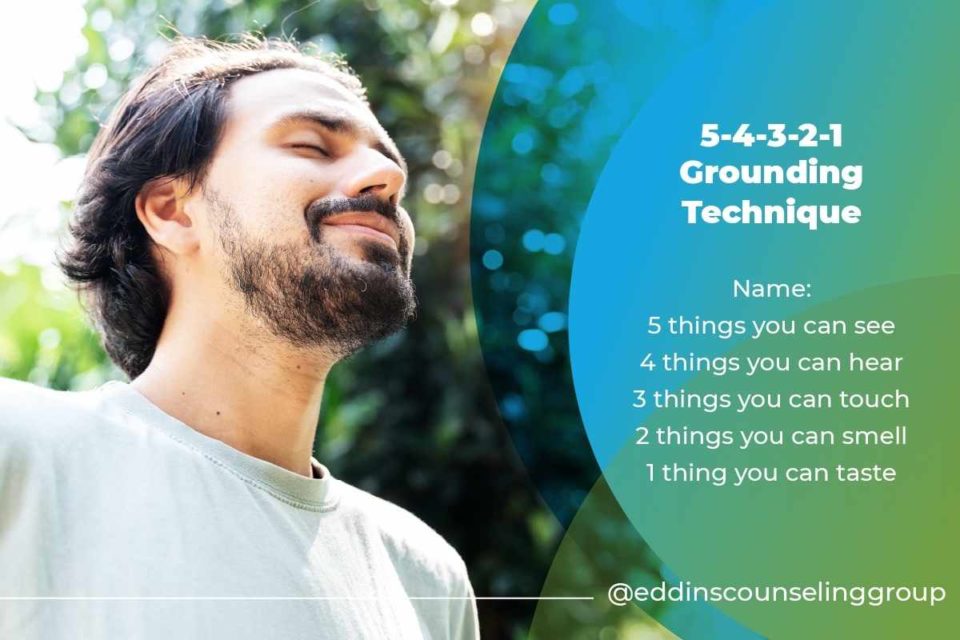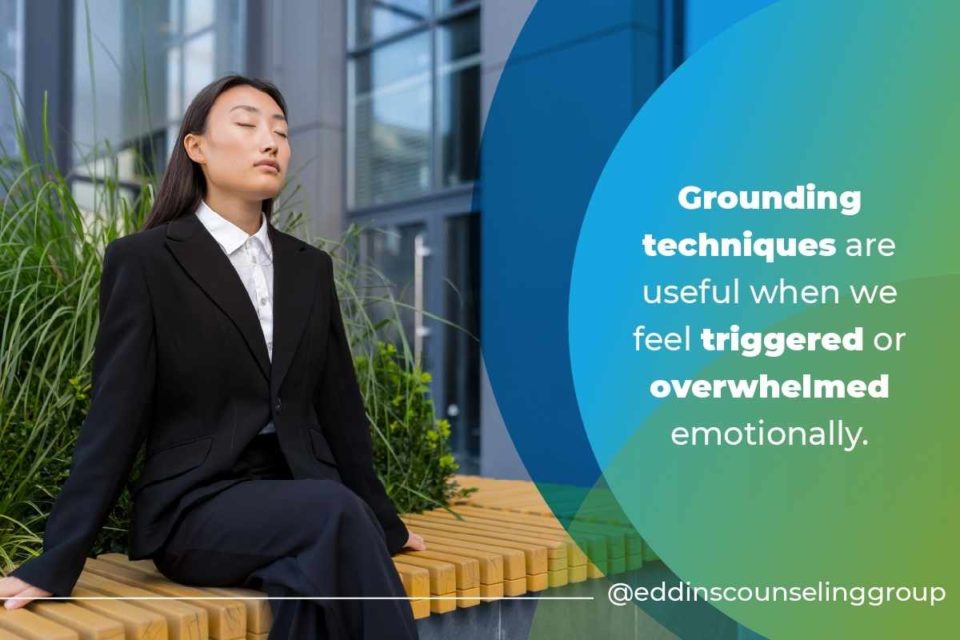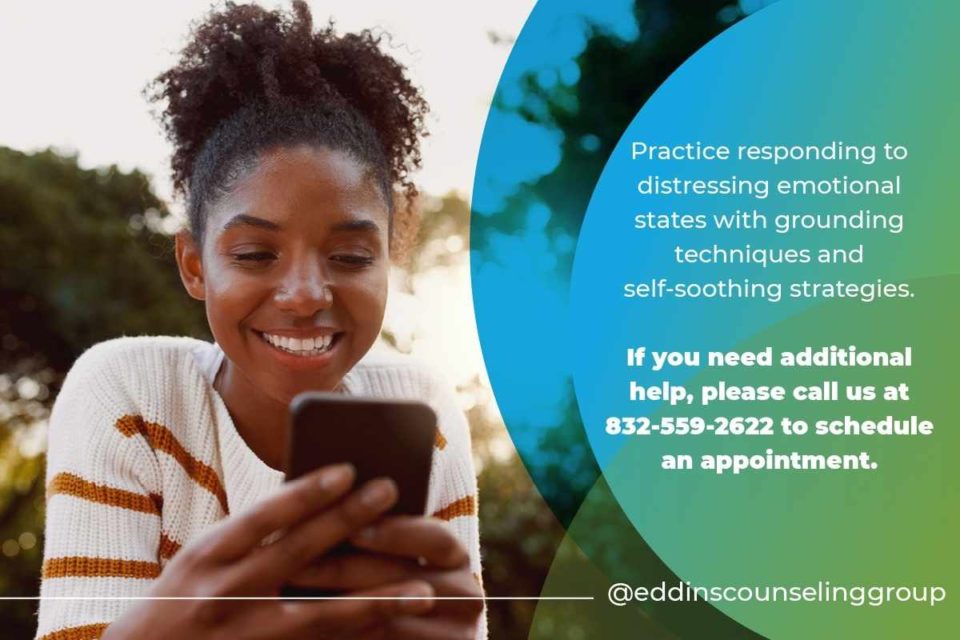April 1, 2020
Grounding Techniques & Self Soothing for Emotional Regulation
Written by Rachel Eddins
Posted in Anxiety, Emotional & Mental Health, Stress Management, Trauma, Grief & Loss and with tags: PTSD/Trauma, emotional health, emotional regulation, grounding, self care, self soothing

Grounding & Self-Soothing Techniques for Adults
Use these skills to self-soothe, calm, and manage difficult, overwhelming emotions and sensations
Learning how to self-soothe is as important for adults as it is for babies. Grounding and self-soothing is how we calm our bodies when we are overloaded by stress or overwhelming emotions.
You may already be practicing some self-soothing or grounding exercises without even realizing it. Expanding your toolbox of skills can help you find something that works when things feel overwhelming or you find it difficult to settle.
If you’ve experienced trauma, self-soothing and grounding exercises are especially important tools to have available.
Grounding Techniques for Anxiety & Stress
Grounding techniques are a set of tools used to assist you to stay in the present moment during episodes of intense stress and anxiety or other overwhelming emotions. Staying in the present moment allows people to feel safe and in control by focusing on the physical world and how they experience it.
Grounding techniques are useful when we feel distressed, overwhelmed emotionally, triggered, or mentally removed from the present moment.
When stressed, we can get caught up in negative thoughts, whether a past difficult experience or interaction or the fear of a future situation happening.
Think of the last time you felt caught up in a distressing emotion. Your body may have felt tense, your mind may have been in the past, re-experiencing previous experiences or in the future, worrying about what’s to come.
You might even feel afraid or uncomfortable being in your body with distressing emotions and have developed strategies to escape it such as binge eating, drinking or other addictions, sleeping, or dissociating.
Grounding Skills Can Help You Feel in Control
If you struggle with a mental illness such as bipolar disorder or an eating disorder, you may also find it uncomfortable to stay in the present moment.
People who have experienced trauma may find themselves feeling hyper-vigilant, irritable or angry, anxious, panicky or hyper-aroused. Conversely, you may also feel frozen or numb. Grounding skills are especially helpful in bringing your body back to homeostasis.
Grounding techniques help bring us back into the here and now in a safe way. The more present you are in your body, the calmer and safer you will feel. You can close your eyes and pay attention to what happens in your body when you practice each of these grounding skills.
When we notice how our body feels in response to different techniques and pay particular attention to the each sensation that feels good, we learn not only that we have more control than we realize, but also which specific tools are helpful.
Closing your eyes can help you to hone in to the specific sensations or changes that occur within your body as you try different tools.
How Grounding Works
Grounding is easy to do. Just focus on some aspect of the physical world, rather than on your internal thoughts and feelings (see suggestions below).
Focus on the present rather than the past. Practice your grounding techniques so that they will come naturally when you are upset.
Let go of any negative feelings.
Try a variety of techniques and rate the effectiveness of each technique in keeping you calm. Have others assist you in using these techniques by reminding you to practice them and use them as soon as you are feeling emotionally distressed.
Click here to see a demonstration of grounding techniques or go to: http://youtu.be/DFxRs1oFiEE.
What Are Some Grounding Techniques?
Here are some suggestions of grounding techniques, but you can make up your own as well. These can be modified for kids as well.
- Run cool water over your hands. Hold onto ice cubes if the urge is intense.
- Place a cool washcloth on your head/face. (Store a hand towel with lavender essential oil in your refrigerator).
- Place an ice pack over your eyes for 30 seconds or put your face in cold water for 30 seconds.
- Grab tightly onto your chair as hard as you can.
- Touch various objects around you: a pen, keys, your clothing, or the wall.
- Dig your heels into the floor-literally “grounding” them! Notice the tension centered in your heels as you do this. Remind yourself you are connected to the ground.
- Carry a grounding object in your pocket, which you can touch whenever you feel triggered.
- Notice your body: the weight of your body in the chair; wiggle your toes in your socks; the feel of your chair against your back…
- Stretch. Roll your head around.
- Clench and release your fists.
- Walk slowly; notice each footstep, saying “left or “right”… in detail to yourself.
- Focus on your breathing, notice each inhale and exhale. Continue for 10 slow, deep breaths.
- Eat something, describing the flavors to yourself.
- Scan the room and notice five things you see in detail.
- Listen for five things that you can hear. The clock ticking, the a/c humming, your own breathing, etc.
- Focus on five things you can feel in contact with your body (ie., your clothes, your back against the chair, your feet on the floor, your hair touching your neck, your watch on your wrist.
- Do the above 3 things simultaneously.
- Describe an everyday activity in great detail. For example cooking a meal, getting ready in the morning:
- First I defrost the turkey in the microwave. While it’s defrosting, I pull out a soup pot and place it on the stove. Then I begin to chop up the vegetables. When the turkey’s ready, I place it in the pot and begin to brown it….
- Count to 10 or say the alphabet. Very s…… l….. o….. w….. .l…… y..
- Describe your environment in detail, using all your senses – for example, “The walls are blue, there are five green chairs, there is a wooden bookshelf against the wall….” Describe objects, sounds, textures, colors, smells, shapes, numbers and temperature. You can do this anywhere,
- Jump up and down (great one for kids!)
5-4-3-2-1 Grounding Technique
Using your 5 senses is a fast way to bring you out of your thoughts or intense emotions into the present moment. This is a simple grounding technique you can do in the moment.
- Name 5 things you can see.
- Name 4 things you can hear.
- Name 3 things you can touch within your immediate reach.
- Name 2 things you can smell.
- Name 1 thing you can taste.
Progressive Muscle Relaxation
Progressive muscle relaxation is a grounding technique in which you intentionally focus on relaxing the muscles in your body.
If you prefer guided instruction, click here for guided progressive muscle relaxation.
- Tense and relax each muscle group, head to toes (or toes to head), one muscle group at a time.
- Tense (5 seconds), then let go; relax the muscle all the way. Notice the tension; notice the difference when relaxed.
- As you relax each muscle, say to yourself, “Relax.”
What are Self-Soothing Skills for Emotional Regulation?
When we are highly stressed, we can also experience emotional dysregulation. If you experience this, you may feel “out of control.”
Perhaps you got angry, yelled and made threats you didn’t mean, you got frustrated and snapped, you felt heavy and depressed, you felt highly anxious, or maybe your emotions felt so intense you shut down.
Self-soothing techniques help you calm and relax when you are feeling overwhelmed both physically and emotionally. They help you to “regulate” so that you can feel like yourself again. Self soothing is what parents do when they pat their infant child’s back or rock them to sleep when they are fussy.
Self-soothing is a skill.
We need self-soothing when we are experiencing pain. The key is to find healthy self-soothing skills that help you cope vs. quick-fix soothing such as addictive behaviors.
Following are some examples to try – keep in mind that you are unique and what works for someone else might not work for you. So keep trying!
Self-Soothing Techniques for Emotional Regulation
- Think of your favorites: favorite movie, color, place, animal, person, season, music.
- Get yourself some hot cocoa, coffee, soda, juice or water. Drink your beverage slowly focusing on the sensations of taste, smell and temperature.
- Give yourself a regulating hug: place your right hand across your heart and put your palm against your body with your hand under your armpit. Take your left arm across the body towards the right and hold your own deltoid or upper arm close to your shoulder for a calming self-hug.
- Wrap in a blanket and rock in a rocking chair.
- Wrap up in a heated blanket or put your clothes/blanket in the dryer to warm up then put them up and relax.
- Take a warm shower or bubble bath.
- Light scented candles or oil.
- Play soothing music.
- Burn essential oils in a diffuser.
- Go out into the warm sun for 15-30 minutes
- Apply a cool washcloth to your face – add lavender essential oil for a calming boost.
- Practice deep breathing or try some of these yoga breathing exercises to shift your mood:
- If you’re feeling depressed, try the breath of joy to energize you.
- Calming and compassionate 3-part breathing.
- Listen to calming and soothing music for 10 minutes.
- Play, pet (and walk) a pet for 10 minutes or more.
- Engage in rhythmic activities (knitting, crocheting, biking, swimming, dancing).
- Chew gum.
- Read an inspirational quote or verse.
- Think of the things you look forward to in the next week (the person you will connect with, activity, etc).
- Picture people you care about and look at pictures of them.
- Say a coping statement – “I can handle this”, “The feeling will pass”.

Slow Your Breathing Down
- Slow your pace of breathing way down. Breathe deeply from the abdomen (belly).
- Breathe out for longer than you breathe in (e.g. 4 seconds in and 8 seconds out).
- Do this for 1-2 minutes to bring down your arousal.
- Exhaling fully activates our body’s relaxation response, which is calming and soothing.
Create a Self-Soothing Distress Kit
It can be helpful to prepare in advance a self-soothing or distress kit. When we’re in the grips of emotional overload it can be difficult to remember the things that work to soothe us.
A distress kit is something you prepare in advance so it’s available to help you at the moment you need it. You can do this any way you want, the key is to prepare something in advance.
If you respond to inspirational sayings, you might create a Pinterest board of your favorite quotes or write down meaningful sayings in a journal or device that you can easily reference later.
You can keep things you want to remember, a favorite picture, gum, and scented lotion all together with you in your purse or backpack.
Get creative, but make it easily accessible.
Use a Weighted Blanket
Weighted blankets have been shown to be helpful in calming the nervous system and allowing your body to relax. This can improve sleep, reduce irritability, and ultimately improve your mood.

Practice Talking to Yourself in a Soothing Way
When stressed, our inner critic is usually the loudest. Unfortunately, a negative critic is not motivating. It just makes you feel worse – more defeated and less confident.
What is needed rather, is a kinder, compassionate, and soothing voice. The voice of someone who loves and cares about you. When we feel safe and connected, we can regulate difficult emotions, increase confidence and have the motivation to try again.
Supportive language helps us cope and get through the hard times.
Soothing words of comfort to say to yourself:
- I’m sorry you’re going through this.
- I’m here for you.
- I love you.
- I know this is a difficult time for you.
- You are not alone.
- I believe in you.
- It’s okay to feel this way, it makes sense to me.
- I can understand …
- You can count on me.
What words most help you feel grounded, secure and embodied? Write them down!
Self-Care Coping Strategies
Coping strategies focused on improving your mood that you can do on your own are sometimes described as self-soothing or self-care coping strategies.
Effective self-soothing coping strategies may be those that involve one or more of the five senses (touch, taste, smell, sight, and sound). These can be highly effective stress reduction strategies!
Listed below are examples of self-soothing strategies for each sense. When engaging in these activities, focus your attention completely on the task, that is, with mindfulness.
Touch
- Soaking in a warm bath
- Getting a massage
- Relaxing in the warmth of the sun
- Stretching
- Going for a swim
- Changing into comfortable clothes
- Playing with an animal
- Put lotion on your body
- Soak your feet
- Sink into a comfortable chair
- Wrap up in a cozy blanket
- Drive with your windows down
- Hug someone
- Put a cold compress on your forehead
Taste
- Eating a comforting meal mindfully
- Sipping herbal tea
- Eating healthy food
- Slowly sucking on hard candy
- Chew a piece of gum
Smell
- Shopping for flowers
- Smelling lavender or vanilla
- Lighting a scented candle
- Deeply breathing in fresh air
- Use favorite soap, shampoo, lotion, perfume
- Open a package of coffee and inhale the aroma
- Use an essential oil diffuser
- Boil cinnamon
Sight
- Seeing a funny movie or watching a funny television show
- Reading a good book
- Looking at pictures of loved ones
- Looking at pictures of a past vacation or places that you would like to visit
- Watching the clouds
- A beautiful flower
- Light a candle and watch the flame
- Spend time outdoors and notice your surroundings
Sound
- Listening to relaxing or invigorating music
- Hum or sing to yourself
- Saying positive statements to yourself or self-encouragement
- Playing a musical instrument
- Pay attention to the sounds of nature/around you
- Create a playlist that will get you through tough times and use
You may also find that you respond to different types of self-care activities depending on your unique personality and preferences. Visit our list of self care activities and identify 1-2 that you can try today.
[gview file=”https://eddinscounseling.com/wp-content/uploads/Self-soothing-exercises-for-each-sense.pdf”]
Releasing Endorphins to Soothe Intense Emotions
If your emotions feel particularly intense, it can be helpful to get some endorphin release to ease the intensity. Try these activities to get a release. Engage in intense aerobic exercise for 10-15 minutes. Expend your body’s stored physical energy by trying one of the following activities. Don’t overdo it!!!
- Run up/down the stairs or the periphery of your house/march in place.
- Do 100 jumping jacks.
- Put on the radio and dance.
- Listen to a funny comedian, watch a funny movie/TV show.
- Read about something that tickles you.
- Hold/stroke and hug a stuffed animal or live pet.
- Hug a pillow, rag doll, or tree.
Practice responding to distressing emotional states with grounding techniques and self-soothing strategies. If these are difficult or you need additional help, please contact us. Therapy can help you develop coping strategies, new perspectives, and skills for managing difficult emotions.
Seek Support From a Specialist
A therapist can help you work with overwhelming or intense emotions, thoughts and sensations so that you experience them less frequently and have greater skills to cope when you do.
Face-to-face services are available in Houston, Montrose, or Sugar Land. Online therapy services through secure, confidential video therapy is also available.
Dialectical Behavioral Therapy
Dialectical Behavioral Therapy has also been shown to be helpful in learning skills to regulate difficult or distressing emotions. DBT is often taught through skills groups.
Find out more about our DBT Skills Therapy Groups:
- DBT Therapy Group for Adults
- DBT Skills Group for High Schoolers
- DBT Skills Group for Parents of Teens
- DBT Skills Group for Middle Schoolers
Trauma Therapies
- Trauma & PTSD Treatment
- Trauma-Focused Cognitive Behavioral Therapy (TF-CBT)
- Brainspotting Trauma Therapy
- What is Brainspotting? (short YouTube video)
- The Science Behind Brainspotting Therapy
- Exploring Brainspotting: How Does it Work? (see blog 7/24/2023)
To get started now give us a call to schedule an appointment at 832-559-2622 or schedule an appointment online.
Download this infographic to remind yourself of grounding techniques you can practice
Download this infographic to keep self-soothing statements these handy!
5 Ways to Reduce Anxiety
Get instant access to your free ebook.
Grounding & Self Soothing
Get instant access to your free ebook.
Create Healthier Thoughts & Feelings
Get instant access to your free ebook.
Why You Feel This Way
Get instant access to your free ebook.
































